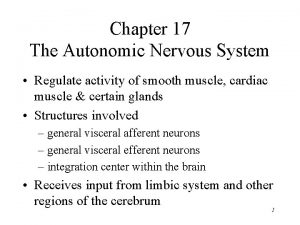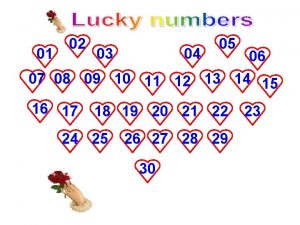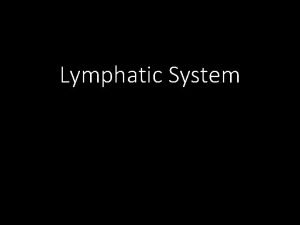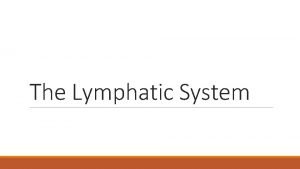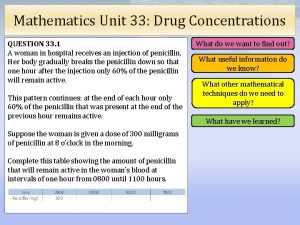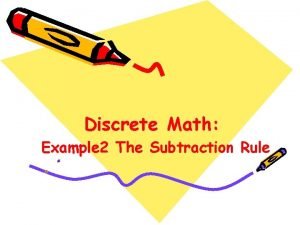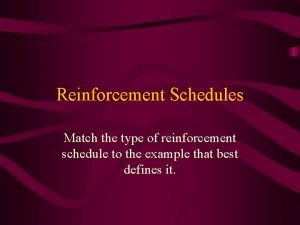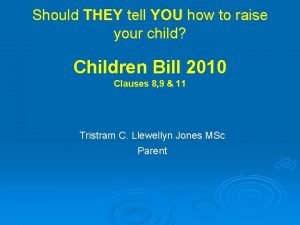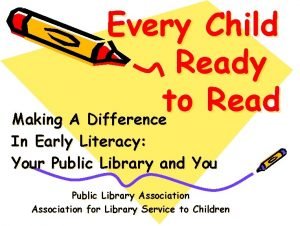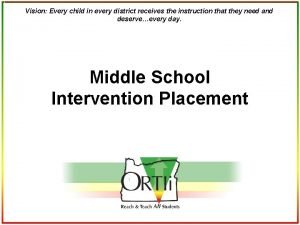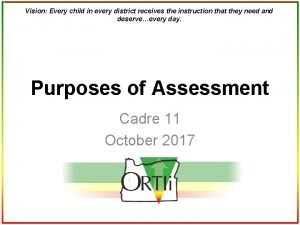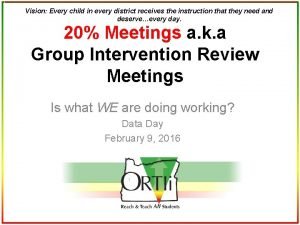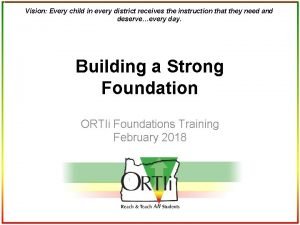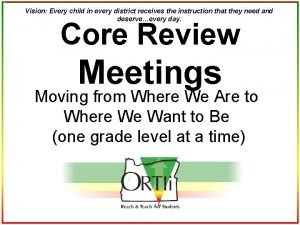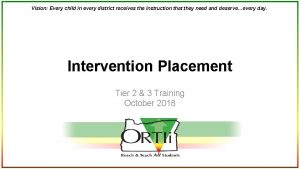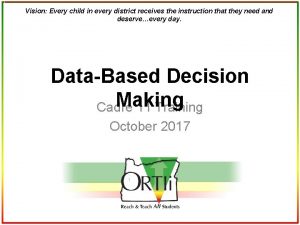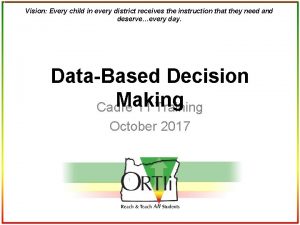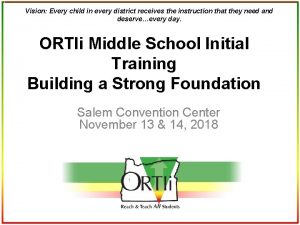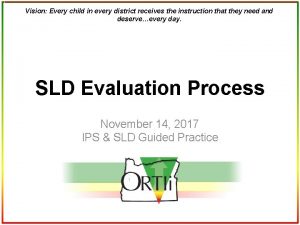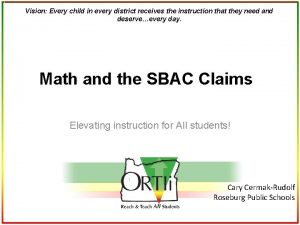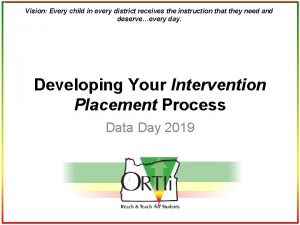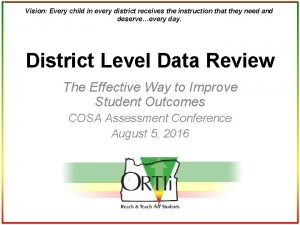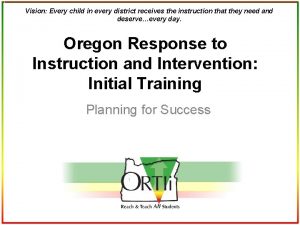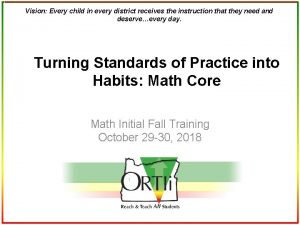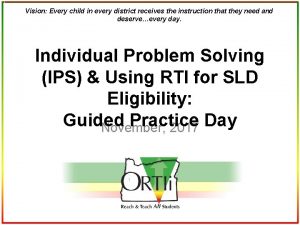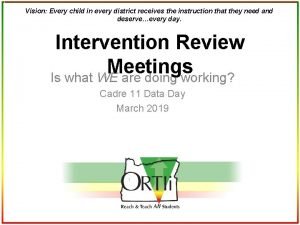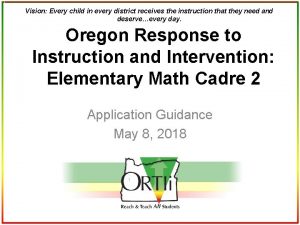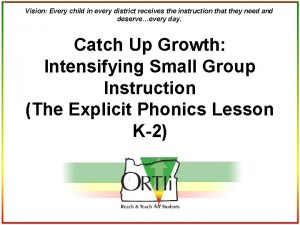Vision Every child in every district receives the



























































- Slides: 59

Vision: Every child in every district receives the instruction that they need and deserve…every day. Developing Your Intervention Placement Process Data Day 2019 FAST Bridge Session

RTI Essential Components Clear Vision of Learning for ALL SLD Decision Making Rules Progress Monitoring Intervention Placement Initial and Ongoing PD Ongoing Coaching BIT Meets Regularly Interventions Intervention Principal Attends RTI Meetings Universal Screening Review Core Review Observe & Actionable Feedback Teaming & DBDM Professional Learning Culture of Collaboration to Improve Outcomes Core Materials and Instruction Leadership Growth Mindset & High Expectations For ALL Students

Today’s information Some information will be new Some information will be review ? ? Some information may help you fine tune what you are currently doing and plan for next year.

Purpose for the Session • Review Intervention Placement Basics • Develop or refine a process to match interventions to student need – Review FAST Bridge reports available to assist in placing students – Provide time to examine your own data & practice placing students into interventions Develop Standards of Practice for Intervention Placement

Installation Matrix

RTI Handbook

RTI Team Meetings Tier 1 Core Meetings Tier 2 & 3 Placement Meetings • Reading • Behavior • Attendance Intervention Review Meeting • Intervention Review Meetings • Reading • Behavior • Attendance Tier 3 Individual Problem Solving Meetings

RTI Team Meetings (Detailed)

Installation Matrix: Intervention Placement

Handbook Guidelines

FAST Bridge: All Reports Screening & Problem Identification Analysis & Planning Intervention & Monitoring

Decision Rules: Intervention Placement • Decision Rule: Percent of students that will be served in interventions – Typically 20% of students are served interventions • Decision rules guide us to make important decisions about students • Your decision rules create consistency & equity across grade levels and schools • Guide how many students should receive interventions

How do we know how many students to place in interventions? Data Research Capacity

Lowest 20% (5 students: 19%) All Low and High Risk (15 students: 58% ) Intervention system overload! 26 Students, 2 nd Grade

Identifying the 20% • In addition to FAST Bridge data, what other data is available to make this decision? – Smarter Balanced Results – Core Assessments – Common Formative Assessments – Language Assessments

Intervention Placement Decision Rule District Standardizes • 20% Decision Rule: The lowest 20% of students at each grade level based on schoolwide screening measures will receive group intervention(s) School Customizes • Determine how many students are placed into interventions based on the school’s data – 20% at each grade level? – More at primary…less at upper? – < 20%?

Team Time • Pick a grade level to examine your Winter screening data from your school. – What percent of students are in the Well Below range? – Does your school have the capacity to serve all Well Below students in interventions? • Can you serve more (i. e. , Below students)?

No amount of intervention supports will fix an insufficient core program

A bit about core…

What to do about kids who you are not serving in interventions? • We sometimes have more students who are in need than we have the capacity to support with interventions • Need to address in small group

A few notes about small group instruction in the core • Allows students to receive instruction focused on their needs • Allows student to progress at their own pace. Small group instruction during core is NOT considered Intervention

How can you group students for small group core instruction? • Four groups formed initially based on: – Performance on two key indicators (skills) – Scores above versus below/well below benchmark • Groups may be subdivided if too large • Teacher revises groupings based on other information about students’ skill levels, resources, etc.

Initial Grouping Suggestions Fluency High Accuracy High Prio ritize inter v stud entions ents for i Grou n this p Fluency High Accuracy Low Accuracy High Fluency Low Accuracy Low

Screening to Intervention (S 2 I) Report • Accuracy • Automaticity (fluency rate) • Broad • Instructional Need • Skill Area

Screening to Intervention (S 2 I) Report (con’t)

Group Skills Report Teachers see a sorted list of student performance by item This report enables teachers to know which specific skills have been mastered by most students and those skills that the group needs more early. Reading Letter Sounds

Talk Time • Where is your staff with small group instruction? – Are teachers aware of the quadrant sort practice? – Do they have skills and materials to target instruction in small group during core?

Installation Matrix: Intervention Placement

Develop district intervention placement guidelines • Develop guidelines for the following: – Use screening data to the identify target skill for your most in need students • Phonemic awareness, phonics, fluency – Determine which interventions match these needs – Correctly place students in interventions using intervention placement tests • Determine logistics

Develop district intervention placement guidelines • Develop guidelines for the following: – Use screening data to the identify target skill for your most in need students • Phonemic awareness, phonics, fluency – Determine which interventions match these needs – Correctly place students in interventions using intervention placement tests • Determine logistics

Intervention Matched to Student Needs (Article by Vanderheyden et al. , 2016 in Edweek) “…intervening without consideration for what a student specifically needs is like choosing an antibiotic without identifying the bacteria causing an infection. ”

Lowest 20% (5 students: 19%) 26 Students, 2 nd Grade

Screening to Intervention (S 2 I) Report • Accuracy • Automaticity (fluency rate) • Broad • Instructional Need • Skill Area

Screening to Intervention (S 2 I) Report (con’t)

Hierarchy of Reading Skills: Identifying the Target Skill Reading Comprehension Phonics (Alphabetic Principle) Phonemic Awareness Foundational Skills K-5 Vocabulary Constructing Meaning Oral Reading Accuracy & Fluency

How do you identify the target skill? • Start with available screening data • In which skills is/are the student in the high risk/well below benchmark range? • Which of these skills is the lowest in the hierarchy of reading skill? Oral Reading Accuracy & Fluency Phonics (Alphabetic Principle) Phonemic Awareness Foundational Skills K-5

Group Detailed Report

Screening Assessments Linked to Big 5 of Reading

Identifying the Target Skill/s Review PA Student/Grade Joey/1 st George/2 nd PSF 20 Phonics Fluency CLS WWR Accuracy ORF 14 0 30 2 Miranda/4 th Composite Well Below 75% 11 Well Below 98% 60 Below Oral Reading Fluency Phonics Phonemic Foundational Skills K-5 Awareness

Practice • Choose a grade level to identify students in need of intervention and the students target skills – Identify the target skill for at least 10 of these students (i. e. , PA, Phonics, Fluency) • (if time permits identify the target skill for more students)

Develop district intervention placement guidelines • Develop guidelines for the following: – Use screening data to the identify target skill for your most in need students • Phonemic awareness, phonics, fluency – Determine which interventions match these needs – Correctly place students in interventions using intervention placement tests • Determine logistics

District Standard Reading Protocol

South Umpqua Standard Reading Protocol (draft) • Review this document to revise as needed • Also, think about your roll-out communication plan – Does everyone know this exists? – Was there representative buy-in from staff? – Is this easily located?

Matching Intervention to Need Phonemic Awareness Phonics for Reading Oral Reading Accuracy & Fluency Read Naturally Corrective Reading Mastery Phonics Blast Phonics Boost/Blitz REWARDS ERI Heggerty

TTSD Matching Matrix

South Umpqua Matching Matrix • Review this document to revise as needed • Also, think about your roll-out communication plan – Does everyone know this exists? – Was there representative buy-in from staff? – Is this easily located?

Develop district intervention placement guidelines • Develop guidelines for the following: – Use screening data to the identify target skill for your most in need students • Phonemic awareness, phonics, fluency – Determine which interventions match these needs – Correctly place students in interventions using intervention placement tests • Determine logistics

Use intervention placement tests to help guide creation of intervention groups Once an intervention program that addresses the instructional need is identified, placement tests should be used to form instructional groups of students. Available resources (time, staff, materials) will guide how many groups are created.

Intervention Placement Guidelines • District Standardizes • How to…. – Use screening data to determine the most in need students – Identify target skill needs • Phonemic awareness, phonics, fluency – Determine which interventions match these needs – Correctly place students in interventions using intervention placement tests • School Customizes • School level considerations for grouping – Behavior – Group size – Available interventionists – Lesson placement

Chart/Activity 4 th Grade • New one from Jon DAZE DORF CWPM and Accuracy Phonics Screener PSF Reading Street 60 min whole group 30 min small group In program assessments 6 Minute Solutions 6 students 15 minutes DORF Rewards 5 students 30 min DORF Heggerty 5 students 5 -10 min PSF

Practice 1. Determine what intervention programs are available to you, and try to categorize them into an instructional need area 2. Practice placing kids into intervention groups by instructional need: – Review your screening data to determine their pattern of skills (e. g. phonics, fluency, etc. )

Develop district intervention placement guidelines • How to…. – Use screening data to determine the most in need students – Identify target skill needs • Phonemic awareness, phonics, fluency – Determine which interventions match these needs – Correctly place students in interventions using intervention placement tests • Determine logistics

Logistics • Record intervention placement – Student Intervention Profile – Progress Monitoring Form • Inform Parents/Guardians – Notification Letter – RTI Brochure

Student Intervention Profile

Progress Monitoring Data Identify start of intervention Phonics for Reading (30 min)

Notification Letter/RTI Brochure

Intervention Placement: Logistics Unacceptable Feature Practice When? Who? Data? Only place students informally Acceptable Practice Formally 1 x per year, review 6 -8 weeks Not involving A trained reading teachers or specialist w/ trained specialists teacher input Classroom data Teacher referral Best Practice Formally 3 x per year, review 6 -8 weeks A team of teachers, specialists, principal, other staff Screening data + SBAC (if applicable) + diagnostic + Classroom Data + placement tests

Refining our practice

Talk Time • Who will be responsible for completing the Student Intervention Review Form? • Who will document Intervention Placement on the Progress Monitoring Data?
 Every child every day
Every child every day Cs766
Cs766 Child vision foundation
Child vision foundation Left child right sibling
Left child right sibling The left side of the heart receives blood from the
The left side of the heart receives blood from the Mark receives a score report detailing his performance
Mark receives a score report detailing his performance Who teases romeo about rosaline and his love-sickness
Who teases romeo about rosaline and his love-sickness Hurrah for the fourth of july cartoon
Hurrah for the fourth of july cartoon Which target organ receives dual innervation
Which target organ receives dual innervation The boeing 747 is twice
The boeing 747 is twice When earth receives energy from the sun, ____.
When earth receives energy from the sun, ____. Base and apex of the heart
Base and apex of the heart Short tube that receives purified lymph
Short tube that receives purified lymph Average weather conditions over time
Average weather conditions over time Short tube that receives purified lymph
Short tube that receives purified lymph A woman in hospital receives an injection of penicillin
A woman in hospital receives an injection of penicillin Subtraction rule example
Subtraction rule example A blueberry picker receives $1 after filling 3 pint boxes.
A blueberry picker receives $1 after filling 3 pint boxes. Tribeculated
Tribeculated A wise man receives correction
A wise man receives correction Why was every child matters scrapped
Why was every child matters scrapped Every child matters be healthy
Every child matters be healthy Orange shirt day quotes
Orange shirt day quotes Every child is gifted they just unwrap
Every child is gifted they just unwrap Nparks every child a seed
Nparks every child a seed Pta every child one voice
Pta every child one voice Every child ready to read six skills
Every child ready to read six skills Every child a seed
Every child a seed Every mother loves her child tag question
Every mother loves her child tag question Every country and every nation
Every country and every nation Every rotarian every year
Every rotarian every year Every nation and every country
Every nation and every country Microsoft empower every person
Microsoft empower every person Every picture has a story and every story has a moment
Every picture has a story and every story has a moment Every knee shall bow every tongue confess
Every knee shall bow every tongue confess độ dài liên kết
độ dài liên kết Chó sói
Chó sói Thiếu nhi thế giới liên hoan
Thiếu nhi thế giới liên hoan điện thế nghỉ
điện thế nghỉ Một số thể thơ truyền thống
Một số thể thơ truyền thống Thế nào là hệ số cao nhất
Thế nào là hệ số cao nhất Trời xanh đây là của chúng ta thể thơ
Trời xanh đây là của chúng ta thể thơ Frameset trong html5
Frameset trong html5 Hệ hô hấp
Hệ hô hấp Các số nguyên tố là gì
Các số nguyên tố là gì đặc điểm cơ thể của người tối cổ
đặc điểm cơ thể của người tối cổ Tia chieu sa te
Tia chieu sa te Các châu lục và đại dương trên thế giới
Các châu lục và đại dương trên thế giới Tư thế worm breton
Tư thế worm breton ưu thế lai là gì
ưu thế lai là gì Tư thế ngồi viết
Tư thế ngồi viết Cái miệng xinh xinh thế chỉ nói điều hay thôi
Cái miệng xinh xinh thế chỉ nói điều hay thôi Các châu lục và đại dương trên thế giới
Các châu lục và đại dương trên thế giới Mật thư tọa độ 5x5
Mật thư tọa độ 5x5 Bổ thể
Bổ thể Tư thế ngồi viết
Tư thế ngồi viết V. c c
V. c c Thẻ vin
Thẻ vin Thơ thất ngôn tứ tuyệt đường luật
Thơ thất ngôn tứ tuyệt đường luật Bài hát chúa yêu trần thế alleluia
Bài hát chúa yêu trần thế alleluia








